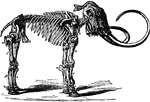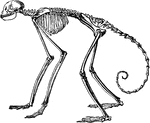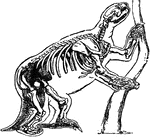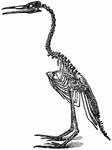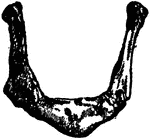
Human Hyoid Bone
The hyoid, os hyoides, or tongue bone, is an isolated, U-shaped bone lying in front of the throat, just…
Archaeopteryx Skeleton
An illustration of an Ichthyosaurus skeleton. Ichthyosaurus is an extinct genus of ichthyosaur from…
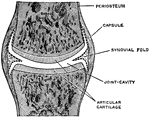
A Simple Complete Joint
A simple complete joint, one type of movable articulation. The synovial membrane is represented by dotted…
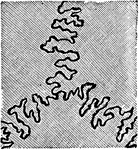
Human Joint, Dentated Suture
A toothed, or dentated suture. This is one type of immovable articulation. It is found in the union…

Human Joint, Mixed Articulation
A mixed articulation (slightly movable). In this form, the bony surfaces are usually joined together…

The Knight and the Lady
"The Knight and the Lady. By Albrecht Dürer. From the engraving on copper." -Heath, 1901

Human Lachrymal Facial Bone
Lachrymal Bone. The lachrymal are the smallest and most fragile bones fo the face. They are situated…
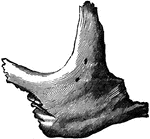
Human Malar (Cheek) Bone
Malar (cheek) bone. The malar bones form the prominence of the cheek, and part of the outer wall and…

Man and Ape Skeletons
This illustration shows the skeletons of Anthropid Apes compared with that of Man.
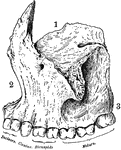
Human Maxillary (Upper Jaw) Bone
Superior maxillary bone. With it's fellow on the opposite side, it forms the whole of the upper jaw.…

Human Maxillary (Upper Jaw) Bone
Inferior Maxillary Bone (lower jaw). It is the largest and strongest bone in the face and serves for…

Megatherium Skeleton
Megatherium ("Great Beast") was a genus of elephant-sized ground sloths that lived from two million…
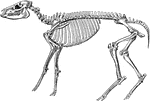
Skeleton of a mesohippus bairdi
"Skeleton of Mesohippus bairdi, the three-toed ancestor of our horse. This animal was about the size…

Moa skeleton
The partial skeleton of a moa, an enormous flightless bird once native to New Zeland, now extinct.

Human Nostril Bone
Inferior turbinated bone, convex surface. The inferior turbinated bones are situated on the outer wall…
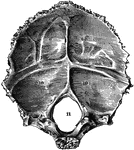
Occipital Bone of the Human Skull
Occipital bone of the human skull, inner surface. It is situated at the back and base of the skull.…
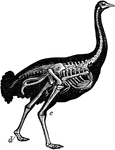
Skeleton of Ostrich
"Shows the powerful legs, small feet, and rudimentary wings of the bird; the obliquity at which the…
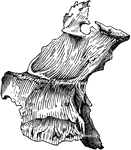
Human Palate Bone
Palate bone. Palate bones form the back part of the roof of the mouth; part of the floor and outer wall…

Parietal Bone of the Human Skull
Parietal bone of the human skull, inner surface. The parietal bones form the greater part of the sides…
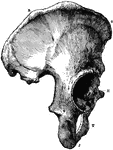
Part of the Human Pelvic Bone
The Os Innominatum, or nameless bone, so called from bearing no resemblance to any known object, is…

Human Pelvis, Male and Female
Male pelvis (top) and female pelvis (bottom). The pelvis is stronger and more massively constructed…

Perch skeleton
"The bones of fishes are of a less dense and compact nature than in the higher order of animals; in…

Perch Skeleton
"The spinal column consists of abdominal and caudal vertebre, the coalescence of the parapophyses into…
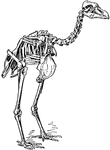
Pezophaps Solitarius (Skeleton)
An illustration of the skeleton of a pezophaps solitarius, part of the dodo family.

Pike Scapulocoracoid
"Pectoral arch and fore limb of the pike (Esox lucius), an osseous fish, showing scapulocoracoid, composed…

Pterodactyl
A remarkable genus of fossil lizards, peculiar to the Mesozoic strata. Its anomalous structure was long…

Pterodactyle skeleton
"So peculiar and strange is the structure of these animals, that the first specimen discovered was classed…
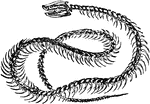
Rattlesnake Skeleton
"The vertebre of serpents are so formed as to admit a great pliancy of the body, which is capable of…

Scapula
"The shoulder-blade is a large, flat, three-sided bone, which is placed on the upper and back…

The Human Scapula
The human scapula bone (shoulder blade). Labels: 1, glenoid cavity; 2, end of the spine of scapula.
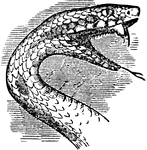
Serpent Head
"The prey of a serpent is oven thicker than the serpent itself, and to admit of its being swallowed,…

Shackle Joint from the Exoskeleton of a Siluroid Fish
"A joint involving the principle of the shackle. Specifically, in anatomy, a kind of articulation found…
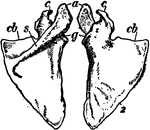
Shoulder blade
"The Scapula, or shoulder blade, is one of the two bones, the other being the clavicle, which form the…

The Human Skeleton
The Human Skeleton. Labels: a, parietal bone; b, frontal; c, cervical vertebrae; d, sternum; e, lumbar…

Skeleton
The framework of animals, which in vertebrates is composed of bone and cartilage. It serves to support…

Axial Skeleton
"Ideal plan of the double-ringed body of a vertebrate. N, neural canal; H, haemal canal; the body separating…
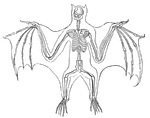
Bat Skeleton
In the bat, the forelimbs are much longer than the hindlimbs and have several of the fingers greatly…

Chacma Baboon Skeleton
"The skeleton, more especially in the higher forms, is in the main similar to that of man, so that only…

Front View of Gorilla Skeleton
"The greatest absolute length of the fore—limb occurs in the gorilla and the orangutan. The humerus…

